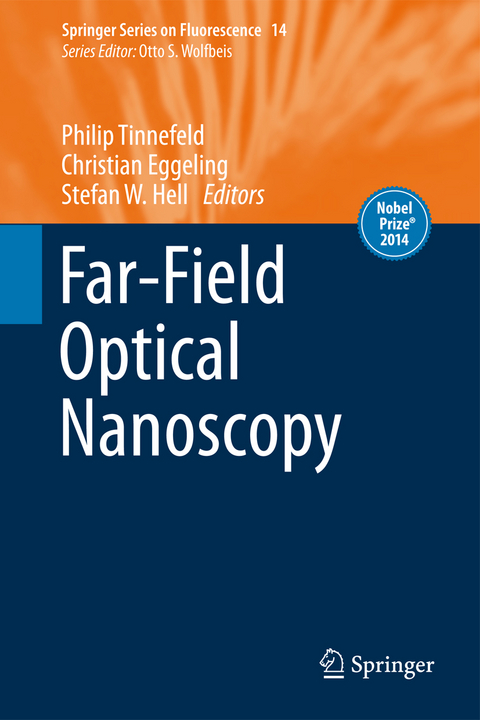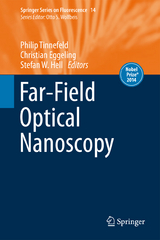Far-Field Optical Nanoscopy
- Coedited by 2014 Nobel Prize® winner Stefan W. Hell
- Featuring contributions by leading experts, including the 2014 Nobel Prize® awardees Stefan W. Hell and William E. Moerner
- Summarizes the latest advances in optical nanoscopy and super-resolution microscopy
- Describes the principles and applications of STED and (f)PALM/STORM, along with advances in fluorescent proteins and organic dyes optimized for fluorescence nanoscopy
This book describes developments in the field of super-resolution fluorescence microscopy or nanoscopy. In 11 chapters, distinguished scientists and leaders in their respective fields describe different nanoscopy approaches, various labeling technologies, and concrete applications.
The topics covered include the principles and applications of the most popular nanoscopy techniques STED and (f)PALM/STORM, along with advances brought about by fluorescent proteins and organic dyes optimized for fluorescence nanoscopy. Furthermore, the photophysics of fluorescent labels is addressed, specifically for improving their photoswitching capabilities. Important applications are also discussed, such as the tracking and counting of molecules to determine acting forces in cells, and quantitative cellular imaging, respectively, as well as the mapping of chemical reaction centers at the nano-scale.
The 2014 Chemistry Nobel Prize® was awarded for the ground-breaking developments of super-resolved fluorescence microscopy. In this book, which was co-edited by one of the prize winners, readers will find the most recent developments in this field.
Stefan W. Hell is director at the Max Planck Institute for Biophysical Chemistry in Göttingen and leads the Department of NanoBiophotonics, as well as the High Resolution Optical Microscopy division at the German Cancer Research Center (DKFZ) in Heidelberg. He is honorary professor of experimental physics at the University of Göttingen and holds a position as adjunct professor of physics at the University of Heidelberg. Stefan Hell has invented the first method, which took optical microscopy into the nano-dimension, breaking Abbe’s diffraction-limited resolution barrier. This breakthrough has been honored with the 2014 Nobel Prize® in Chemistry, awarded jointly to Stefan W. Hell and his colleagues Eric Betzig and William E. Moerner. Hell received his PhD from the University of Heidelberg in 1990 and worked at the European Molecular Biology Laboratory Heidelberg (EMBL) from 1991 to 1993. Afterwards he worked as senior researcher at the University of Turku, Finland and visiting scientist at the University of Oxford, England, before moving to the Max Planck Institute for Biophysical Chemistry in Göttingen in 1997. After building up his research group at the institute, he was appointed as a director in 2002 and established the department of Nanobiophotonics at the institute.
Philip Tinnefeld is Professor of Biophysical Chemistry at the TU Braunschweig. He received his PhD in Physical Chemistry from the University of Heidelberg. Afterwards he did research at the Universities of California in Los Angeles, Heidelberg, Leuven, and Bielefeld. From 2007 to 2010 Tinnefeld was Professor of Biophysics at LMU München, before moving to Braunschweig, where he now leads the group of NanoBioSciences at the Institute of Physical and Theoretical Chemistry of the TU Braunschweig.
Christian Eggeling is Professor of Molecular Immunology at the University of Oxford and Scientific Director at the Wolfson Imaging Centre Oxford, Weatherall Institute of Molecular Medicine. Eggeling received his PhD from the Georg-August University Göttingen. Afterwards he did postdoctoral research at the Karolinska-Institute in Stockholm, Sweden. From 2000 to 2004 Eggeling worked at the company Evotec OAI AG Hamburg, before joining the NanoBiophotonics department of Stefan Hell at the Max-Planck-Institute for Biophysical Chemistry in Göttingen. In 2012 he moved to Oxford as Group Leader of the MRC Human Immunology Unit (HIU).
Part I: Optical Nanoscopy Techniques
STED Fluorescence Nanoscopy
Christian Eggeling, Stefan W. Hell
Super-Resolution Imaging Through Stochastic Switching and Localization of Single Molecules: An Overview
Ke Xu, Sang-Hee Shim, and Xiaowei Zhuang
A Practical Guide to dSTORM: Super-Resolution Imaging with Standard Fluorescent Probes
Markus Sauer
Part II: Labelling Technology for Optical Nanoscopy
Single-Molecule Photocontrol and Nanoscopy
Matthew D. Lew, Steven F. Lee, Michael A. Thompson, Hsiao-lu D. Lee, and W. E. Moerner
Probes for Nanoscopy: Fluorescent Proteins
Susan Gayda, Per Niklas Hedde, Karin Nienhaus, and G. Ulrich Nienhaus
Tailoring Fluorescent Labels for Far-Field Nanoscopy
Dmytro A. Yushchenko and Marcel P. Bruchez
Probes for Nanoscopy: Photoswitchable Fluorophores
Pedro F. Aramendia and Mariano L. Bossi
Far-Field Nanoscopy with Conventional Fluorophores: Photostability, Photophysics, and Transient Binding
Thorben Cordes, Jan Vogelsang, Christian Steinhauer, Ingo H. Stein, Carsten Forthmann, Andreas Gietl, Jürgen J. Schmied, Guillermo P. Acuna, Sebastian Laurien, Birka Lalkens, and Philip Tinnefeld
Part III: Developments and Applications of Optical Nanoscopy
NASCA Microscopy: Super-Resolution Mapping of Chemical Reaction Centers
Gert De Cremer, Bert F. Sels, Dirk E. De Vos, Johan Hofkens, and Maarten B.J. Roeffaers
Counting Molecules: Toward Quantitative Imaging
Maximilian H. Ulbrich
In Vivo Tracking of Single Biomolecules: What Trajectories Tell Us About the Acting Forces
Mario Brameshuber and Gerhard J. Schütz
"This is the first comprehensive book that summarizes most of the superresolution imaging techniques, and as such it is an excellent resource for newcomers to the field. ... a unique and much needed resource that contains a detailed description of all the superresolution techniques and methods that led to the award of the Nobel Prize in Chemistry in 2014. It is a great first resource for anyone wanting to learn more about this rapidly evolving field of research." (Thomas Huser, Analytical and Bioanalytical Chemistry, Vol. 408, 2016)
| Erscheint lt. Verlag | 13.3.2015 |
|---|---|
| Reihe/Serie | Springer Series on Fluorescence ; 14 |
| Verlagsort | Berlin |
| Sprache | englisch |
| Maße | 155 x 235 mm |
| Gewicht | 690 g |
| Einbandart | gebunden |
| Themenwelt | Naturwissenschaften ► Biologie ► Biochemie |
| Naturwissenschaften ► Chemie ► Analytische Chemie | |
| Naturwissenschaften ► Chemie ► Physikalische Chemie | |
| Technik | |
| Schlagworte | Biological Microscopy • Chemistry Nobel Prize 2014 • Chemistry Nobel Prize® 2014 • (d)STORM,(f)PALM, GSDIM • Far-field fluorescence microscopy • fluorescence labelling • Fluorescent proteins • Nasca • optical nanoscopy • optical super-resolution microscopy • organic dyes • photoswitchable labels • Single-molecule Tracking • STED • Stefan W. Hell • William E. Moerner |
| ISBN-10 | 3-662-45546-3 / 3662455463 |
| ISBN-13 | 978-3-662-45546-3 / 9783662455463 |
| Zustand | Neuware |
| Haben Sie eine Frage zum Produkt? |
aus dem Bereich




